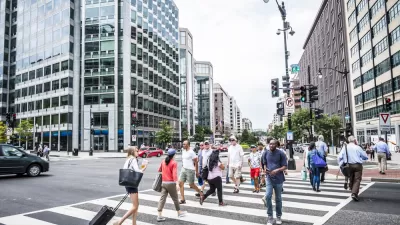The growing popularity of active transportation requires planners and advocates to better survey how, where, and when people are biking and walking. A new study by the Transportation Research Board shares the cutting edge of survey techniques.
The Transportation Research Board has released a new study called “Monitoring Bicyclist and Pedestrian Travel and Behavior.” The study gathers and disseminates the growing body of knowledge of technology and techniques for monitoring the active transportation modes of walking and biking.
Acknowledging that the “methods to monitor the traffic of [biking and walking] have been slow to advance until the last decade or so” the report sets out to “chronicle the most recent advancements in techniques and technology of active transportation monitoring…”
As evidence of the growing need to monitor active forms of transportation—by planners and engineers as well as citizen advocates—the report claims that the results of a search in Google Scholar for the terms “bicycle pedestrian traffic count,” produced more than 1,600 results in 2011, up from only about 50 related publications in 1990.
Such monitoring activities have already gained institutional legitimacy as well. “The past year (2013) has brought a major revision of FHWA’s Traffic Monitoring Guide (TMG)…[which] includes for the first time a chapter on monitoring bicycling and walking (Chapter 4: Traffic Monitoring for Non-Motorized Traffic).”
The report includes guidance on manual techniques, portable counters, and permanent counters, as well archiving and sharing data.
FULL STORY: Monitoring Bicyclist and Pedestrian Travel and Behavior

Planetizen Federal Action Tracker
A weekly monitor of how Trump’s orders and actions are impacting planners and planning in America.

Restaurant Patios Were a Pandemic Win — Why Were They so Hard to Keep?
Social distancing requirements and changes in travel patterns prompted cities to pilot new uses for street and sidewalk space. Then it got complicated.

Map: Where Senate Republicans Want to Sell Your Public Lands
For public land advocates, the Senate Republicans’ proposal to sell millions of acres of public land in the West is “the biggest fight of their careers.”

Maui's Vacation Rental Debate Turns Ugly
Verbal attacks, misinformation campaigns and fistfights plague a high-stakes debate to convert thousands of vacation rentals into long-term housing.

San Francisco Suspends Traffic Calming Amidst Record Deaths
Citing “a challenging fiscal landscape,” the city will cease the program on the heels of 42 traffic deaths, including 24 pedestrians.

California Homeless Arrests, Citations Spike After Ruling
An investigation reveals that anti-homeless actions increased up to 500% after Grants Pass v. Johnson — even in cities claiming no policy change.
Urban Design for Planners 1: Software Tools
This six-course series explores essential urban design concepts using open source software and equips planners with the tools they need to participate fully in the urban design process.
Planning for Universal Design
Learn the tools for implementing Universal Design in planning regulations.
Heyer Gruel & Associates PA
JM Goldson LLC
Custer County Colorado
City of Camden Redevelopment Agency
City of Astoria
Transportation Research & Education Center (TREC) at Portland State University
Camden Redevelopment Agency
City of Claremont
Municipality of Princeton (NJ)




























